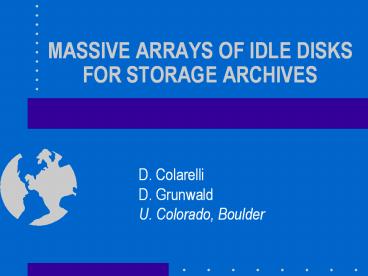MASSIVE ARRAYS OF IDLE DISKS FOR STORAGE ARCHIVES - PowerPoint PPT Presentation
Title:
MASSIVE ARRAYS OF IDLE DISKS FOR STORAGE ARCHIVES
Description:
All MAID configurations achieve similar power consumptions ... MAID can achieve average response times comparable to that of an always on ... – PowerPoint PPT presentation
Number of Views:216
Avg rating:3.0/5.0
Title: MASSIVE ARRAYS OF IDLE DISKS FOR STORAGE ARCHIVES
1
MASSIVE ARRAYS OF IDLE DISKS FOR STORAGE ARCHIVES
- D. Colarelli
- D. Grunwald
- U. Colorado, Boulder
2
Highlights
- Paper proposes
- To replace tape libraries by large non-redundant
arrays of disks - To cache on active drives
- Files that have been recently accessed
- Update logs for other files
- To keep other drives mostly inactive by spinning
them down between accesses
3
Introduction (I)
- Robotic tape libraries are now the standard
solution for archiving very large amounts of data - Disadvantages include
- Slow access timesaverage search time of 41s for
T9940 drives - Not much cheaper than disk drives
- Could we replace tem by massive arrays of hard
drives?
4
Introduction (II)
- Major limitation of hard drive solution is power
consumption - Almost ten times that of equivalent tape library
- Could power down disks that are not currently
accessed - 50 of data are likely to be never accessed
- 25 of data are likely to be accessed once
5
Introduction (III)
- Must be at least as reliable as tape libraries
- No need to use a redundant scheme
- Solution is Massive Array of Inactive Drives
- Paper investigates design issues through
trace-driven simulations
6
Design Issues
- Two major design decisions
- Data migration or duplication (caching)
- File system or block-level interface
7
Migration or caching
- Migration would move hot data to active drives
- Migration uses disk space more efficiently
- Requires a map or directory mechanism that maps
the storage across all drives
- Caching would cache read data and act as a write
log for write data - Keeps two copies of all cached files
- Maps or directories are proportional to size of
cache
8
File system or block interface
- Could use file system information to cache entire
files - Would probably perform better
- Would require system modifications
- Would work with existing systems
9
MAID with caching
Passive drives(spin up/down)
Active drives (always on)
Passive Drive Manager
Cache Manager
Virtualization Manager
10
Design choices (I)
- Compared MAID-cache and MAID-no cache
- MAID-cache
- Caches read and writes on active drives
- Caching unit is chunk of 64 sectors
- Cache policy is LRU
- All writes are placed in the cache write-log
where they wait to be committed to the
non-active (passive) drives
11
Design choices (II)
- Must always check write log before reading data
from the cache or the passive drives - Passive drives remain on standby until
- A cache miss occurs
- The write log becomes too long
- Return to standby when spin-down inactivity time
limit is reached - Varying time limit is primary way to affect
system performance and energy consumption
12
Simulation parameters
- Power management policy
- Always on
- Fixed-delay spin-down
- Adaptive spin-down
- Data layout
- Linear keep successive blocks on same drive
- Striped the opposite
- Caching/No caching
13
Simulation results
- Based on a supercomputer center workload
- All MAID configurations achieve similar power
consumptions - 15 to 16 of that of always on configuration
- MAID configurations w/o cache have average
response times comparable to that of always on
configuration - Workload had little locality
14
Simulation results (II)
- Average response times of MAID configurations
with cache much worse than that of always on
configuration - 0.680 to 0.720 s compared to 0.303 s
- Striped configuration with fixed spin-down delay
has lowest average response time of all MAID
configurations - 0.309 s
15
Conclusion
- MAID can achieve average response times
comparable to that of an always on configuration
with a much lower power consumption
IMPORTANT In a more
recent paper, the authors found out that cached
configurations worked much better for workloads
exhibiting more locality of accessesthan their
supercomputer center workload































